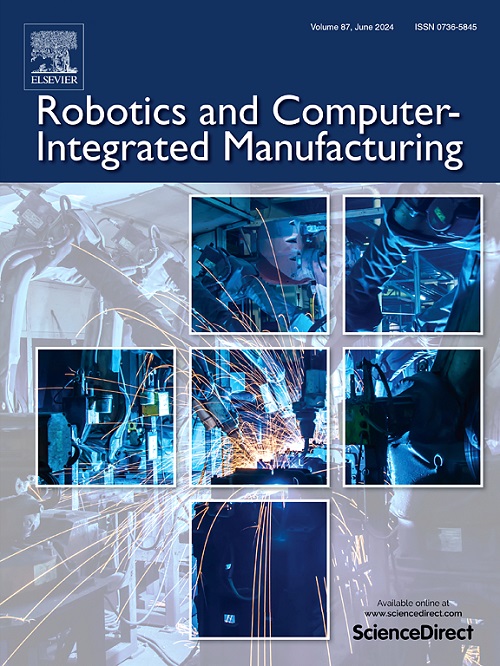An adaptive disturbance compensation method for force-sensorless control systems applied to robotic milling
IF 11.4
1区 计算机科学
Q1 COMPUTER SCIENCE, INTERDISCIPLINARY APPLICATIONS
引用次数: 0
Abstract
This paper introduces a novel disturbance compensation method for a robust, active-force-controlled end-effector. This system integrates a disturbance observer (DOB) and a reaction force observer (RFOB) while employing a numerical optimization-based extremum-seeking algorithm. Conventional force/torque sensors, when employed in serially connected manipulator systems, often trigger unstable responses due to the presence of non-collocated modes. Furthermore, conventional reaction force observers may fail to accurately estimate the contact force between the robot and its environment when external disturbance terms are not perfectly modeled a priori. In response to these challenges, recent research has reintegrated force/torque sensors into the control architecture, employing filter-based sensor fusion techniques to mitigate disturbance effects. However, these approaches fail to address the inherent stability challenges caused by the mounting and serial connection of force/torque sensors within the robot manipulator system, which in turn increases the design complexity of reaction-force-observer-based force control systems. To overcome these limitations, this paper proposes adaptive disturbance compensation methods that leverage position feedback information related to the depth of cut in milling processes. The proposed method adaptively compensates for time-varying disturbances, such as tool wear and abrupt feed rate changes, ensuring consistent performance under dynamic conditions. Compared to conventional position-controlled and force-controlled methods, the proposed approach exhibits improved robustness, precision, and versatility, positioning it as a promising solution for advancing robotic milling technologies toward practical industrial applications.
应用于铣削机器人无力传感器控制系统的自适应扰动补偿方法
介绍了一种鲁棒主动控制末端执行器的扰动补偿方法。该系统集成了扰动观测器(DOB)和反作用力观测器(RFOB),并采用了基于数值优化的极值搜索算法。传统的力/扭矩传感器,当用于串行连接的机械手系统时,由于存在非配置模式,通常会触发不稳定的响应。此外,当外部干扰项没有完美地先验建模时,传统的反作用力观测器可能无法准确估计机器人与其环境之间的接触力。为了应对这些挑战,最近的研究将力/扭矩传感器重新集成到控制体系结构中,采用基于滤波器的传感器融合技术来减轻干扰影响。然而,这些方法未能解决机器人操纵系统中力/扭矩传感器的安装和串行连接所带来的固有稳定性挑战,这反过来又增加了基于反力观测器的力控制系统的设计复杂性。为了克服这些限制,本文提出了利用铣削过程中与切削深度相关的位置反馈信息的自适应干扰补偿方法。该方法对刀具磨损和进给量突变等时变扰动进行自适应补偿,保证了动态条件下的性能一致性。与传统的位置控制和力控制方法相比,所提出的方法具有更好的鲁棒性、精度和通用性,使其成为将机器人铣削技术推向实际工业应用的有前途的解决方案。
本文章由计算机程序翻译,如有差异,请以英文原文为准。
求助全文
约1分钟内获得全文
求助全文
来源期刊
CiteScore
24.10
自引率
13.50%
发文量
160
审稿时长
50 days
期刊介绍:
The journal, Robotics and Computer-Integrated Manufacturing, focuses on sharing research applications that contribute to the development of new or enhanced robotics, manufacturing technologies, and innovative manufacturing strategies that are relevant to industry. Papers that combine theory and experimental validation are preferred, while review papers on current robotics and manufacturing issues are also considered. However, papers on traditional machining processes, modeling and simulation, supply chain management, and resource optimization are generally not within the scope of the journal, as there are more appropriate journals for these topics. Similarly, papers that are overly theoretical or mathematical will be directed to other suitable journals. The journal welcomes original papers in areas such as industrial robotics, human-robot collaboration in manufacturing, cloud-based manufacturing, cyber-physical production systems, big data analytics in manufacturing, smart mechatronics, machine learning, adaptive and sustainable manufacturing, and other fields involving unique manufacturing technologies.

 求助内容:
求助内容: 应助结果提醒方式:
应助结果提醒方式:


